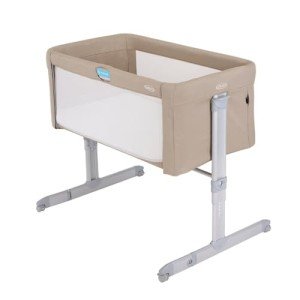10 Signs To Watch For To Get A New Bedside Cot For Co-Sleeping

The Benefits and Considerations of Bedside Cots for Co-Sleeping
Co-sleeping has emerged as a popular option for many new parents who seek to preserve close proximity to their infants throughout the night. Along with standard co-sleeping practices, bedside cots are gaining traction as an option that uses both the convenience of closeness and the safety of different sleeping spaces. This post aims to explore the principle of bedside cots for co-sleeping, highlighting their benefits, prospective downsides, ideas for selection, and typical concerns.
Comprehending Bedside Cots
Bedside cots, also understood as side-sleepers or co-sleepers, are specifically developed cribs that are affixed to the side of the parents' bed. They allow parents to keep easy access to their infants in the evening while providing a separate sleeping location that can boost safety and convenience.
Features of Bedside Cots
- Size and Design: Bedside cots are frequently smaller than standard cribs but still offer sufficient room for an infant. Most designs have adjustable heights to match the bed.
- Side Panels: Many models include detachable or mesh side panels that permit for safe visual tracking of the baby, boosting parents' ability to react to their baby's needs quickly.
- Stability and Safety: Bedside cots are built with stability in mind, including security anchors or straps that secure the cot to the parent's bed.
- Reduce of Access: Parents can quickly reach over to comfort or feed their baby without needing to get out of bed, helping with nighttime breastfeeding or soothing.
Benefits of Using Bedside Cots for Co-Sleeping
- Enhanced Bonding: Proximity to the baby promotes emotional connection and bonding, which is important throughout the early phases of development.
- Easier Nighttime Care: Nighttime feeding and soothing become considerably easier with a bedside cot, as parents can merely lean over to attend to their baby's requirements.
- Increased Safety: Bedside cots decrease the risk of suffocation or unintentional rolls that can accompany traditional co-sleeping directly in the adult bed.
- Individual Sleep Space: The documents supports that having their own sleeping space can help infants sleep much better in terms of less disruptions from parents.
- Transitioning: A bedside cot can be a practical transitional tool as babies grow and begin to transfer to their own spaces.
| Function | Benefits |
|---|---|
| Boosted Bonding | Closer physical presence |
| Easier Access | Quick response to requirements |
| Increased Safety | Minimized danger of accidents |
| Individual Space | Less disruption at night |
| Streamlined Transition | Simpler relocate to independent sleeping |
Considerations Before Choosing a Bedside Cot
While bedside cots provide many benefits, potential users should think about the following elements:
- Size of Bed: Ensure that the cot fits adjacent to the bed without causing discomfort or overcrowding.
- Spending plan: Prices can differ substantially amongst various brand names and designs, so think about spending plan restrictions thoroughly.
- Safety Standards: Check that the cot satisfies all safety guidelines to ensure it is free from harmful products and includes required security features.
- Product: Non-toxic surfaces and products are most importantly important for infant health.
- Infant's Age and Weight: Some cots have weight limitations, and parents should select appropriately based upon their baby's growth.
Tips for Selecting a Bedside Cot
- Read Reviews: Look for user feedback and security ratings.
- Check for Certifications: Ensure the cot complies with security standards.
- Inspect the Design: Choose a design that matches your bedroom design while guaranteeing performance.
- Consider Accessibility: Look for models that permit easy reach but minimize the danger of rolling out.
- Test Stability: Ensure that the cot is steady and protected when connected to the bed.
Common FAQs About Bedside Cots for Co-Sleeping
Q1: Are bedside cots safe for co-sleeping?
A1: When used properly, bedside cots are created to offer a safe sleeping option for infants while allowing close distance to parents. Constantly ensure to secure the cot properly to prevent movements that might cause accidents.
Q2: At what age can I begin utilizing a bedside cot?A2: Many parents begin utilizing bedside cots right after the baby is born. However, it is important to seek advice from with a doctor regarding your infant's readiness for co-sleeping, especially if they were born too soon. Q3: Can I use a regular
crib for co-sleeping? A3: While routine cribs can be utilized, they do not provide the exact same level of ease of access and safety as bedside cots, making bedside options more beneficial for co-sleeping. Bedside Cot For Versatile Use : What if my baby rolls over?A4: Most bedside cots are created with security features that reduce dangers if a baby rolls. Additionally,
they are usually low enough that a roll would not result in a significant drop. Q5: How do I transition my baby from a bedside cot to a regular crib?A5: Gradually move your baby to a separate crib in their own room after they end up being accustomed to oversleeping the bedside cot. Start with naps in the crib while keeping nighttime co-sleeping up until they adapt. Bedside cots present a practical and more secure alternative to direct co-sleeping, supplying many advantages in regards to convenience and security. They facilitate bonding
between infants and parents while lessening the dangers connected with standard co-sleeping practices. Parents trying to find a method to keep their babies close at night ought to consider the advantages that bedside cots can offer. With a careful assessment of alternatives readily available, parents can create a safe and comfortable sleep environment that supports their household's special needs.

